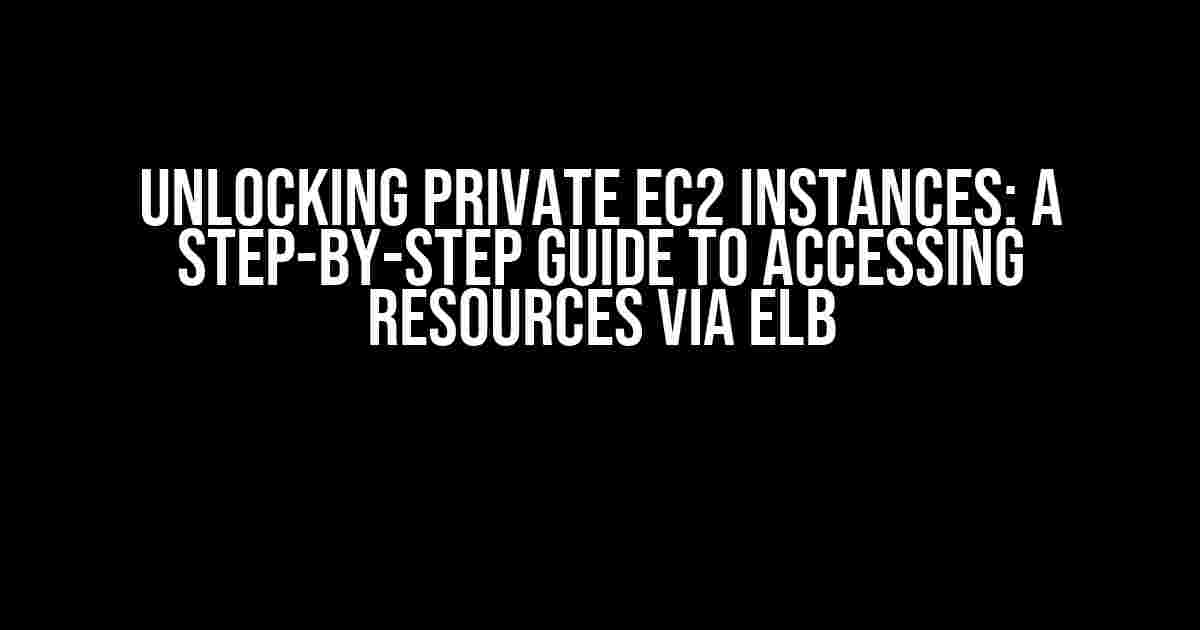Are you struggling to access resources in a private EC2 instance via ELB? You’re not alone! Many developers and engineers face this challenge, but fear not, dear reader, for we’ve got you covered. In this comprehensive guide, we’ll walk you through the process of gaining access to those elusive resources in a private EC2 instance using an Elastic Load Balancer (ELB).
Why Do I Need to Use an ELB to Access Private EC2 Instances?
Before we dive into the nitty-gritty of accessing resources, let’s take a step back and understand why we need an ELB in the first place. A private EC2 instance, as the name suggests, is not publicly accessible. This means that you can’t simply use the instance’s public IP address or DNS name to access resources like you would with a public instance.
That’s where an ELB comes into play. An ELB acts as a reverse proxy, allowing you to route incoming traffic from the internet to your private EC2 instance. But, how do we configure the ELB to access resources in the private instance? That’s what we’ll cover in this article.
Prerequisites: What You’ll Need to Get Started
Before we begin, make sure you have the following prerequisites in place:
- A private EC2 instance with a security group that allows incoming traffic on the desired port (e.g., HTTP or HTTPS)
- An ELB set up in the same VPC as your private EC2 instance
- A configured Route 53 zone or a DNS service of your choice
- A basic understanding of AWS services and security groups
Step 1: Configure Your ELB
First things first, let’s configure our ELB to point to our private EC2 instance. Follow these steps:
- Log in to the AWS Management Console and navigate to the EC2 dashboard
- Select the ELB you created earlier and click on the “Actions” dropdown menu
- Click on “Edit” to enter the ELB configuration page
- In the “Listeners” tab, click on the “Edit” button next to the listener you want to configure
- Select the “Instance” protocol and enter the instance’s private IP address and port number (e.g.,
10.0.0.10:80) - Click “Save” to save your changes
Step 2: Update Your Security Group
Next, we need to update the security group associated with our private EC2 instance to allow incoming traffic from the ELB. Follow these steps:
- Navigate to the VPC dashboard and select the security group associated with your private EC2 instance
- Click on the “Actions” dropdown menu and select “Edit” to enter the security group configuration page
- In the “Inbound rules” tab, click on the “Add rule” button
- Select “HTTP” or “HTTPS” as the protocol, depending on your requirements
- Enter the ELB’s security group ID in the “Source” field (e.g.,
sg-12345678) - Click “Save” to save your changes
Step 3: Configure Your Route 53 Zone (Optional)
If you want to use a custom domain name to access your private EC2 instance, you’ll need to configure a Route 53 zone. Follow these steps:
- Navigate to the Route 53 dashboard and select the hosted zone you created earlier
- Click on the “Create resource record set” button
- Select “Alias” as the type and enter the ELB’s DNS name (e.g.,
my-elb-1234567890.us-west-2.elb.amazonaws.com) - Enter the custom domain name you want to use (e.g.,
example.com) - Click “Create resource record set” to save your changes
Step 4: Test Your Setup
Now that we’ve configured our ELB, security group, and Route 53 zone (if applicable), it’s time to test our setup. Follow these steps:
- Open a web browser and navigate to the custom domain name you set up (e.g.,
http://example.com) - If everything is configured correctly, you should see the contents of your private EC2 instance
- If you encounter any issues, check the ELB logs, security group configurations, and Route 53 zone settings to troubleshoot the problem
Conclusion
Accessing resources in a private EC2 instance via ELB might seem daunting at first, but with these step-by-step instructions, you should be able to get it up and running in no time. Remember to double-check your security group configurations, ELB settings, and Route 53 zone setup to ensure everything is working as expected.
By following this guide, you’ve not only gained access to resources in your private EC2 instance but also taken a crucial step towards building a more secure and scalable architecture. Pat yourself on the back, and happy coding!
| Step | Description |
|---|---|
| 1 | Configure your ELB to point to your private EC2 instance |
| 2 | Update your security group to allow incoming traffic from the ELB |
| 3 | Configure your Route 53 zone (optional) |
| 4 | Test your setup |
// Sample ELB configuration
{
"Listeners": [
{
"Protocol": "HTTP",
"Port": 80,
"InstancePort": 80,
"InstanceProtocol": "HTTP"
}
]
}
Note: This article is for educational purposes only and does not cover all possible scenarios or edge cases. Be sure to follow best practices and consult the official AWS documentation for more information on configuring ELBs and security groups.
Frequently Asked Question
Are you struggling to access resources in a private EC2 instance via ELB? Worry not, we’ve got you covered! Here are some frequently asked questions to help you overcome this hurdle.
Q1: Why can’t I access my private EC2 instance resources through ELB?
By default, private EC2 instances are not accessible from the internet, which means your ELB can’t talk to them directly. You need to add an additional layer of configuration to allow the ELB to communicate with your private instance. Think of it like adding a special key to unlock the door to your private instance!
Q2: What’s the role of a Target Group in allowing ELB to access private EC2 instance resources?
A Target Group is a crucial component that enables ELB to route traffic to your private EC2 instance. It acts as a bridge between the ELB and your instance, allowing the ELB to forward requests to the instance and receive responses. Think of it like a messenger who connects the ELB to your private instance!
Q3: How do I configure my private EC2 instance to accept traffic from the ELB?
To allow your private EC2 instance to accept traffic from the ELB, you need to configure the instance’s security group to allow inbound traffic from the ELB’s security group. This ensures that the ELB can communicate with your instance and forward requests. It’s like giving your instance permission to chat with the ELB!
Q4: Do I need to configure the ELB to use HTTPS to access my private EC2 instance resources?
Yes, it’s highly recommended to configure the ELB to use HTTPS (SSL/TLS) to access your private EC2 instance resources. This ensures that the communication between the ELB and your instance is encrypted, providing an additional layer of security. It’s like sending a secret message that only the ELB and your instance can understand!
Q5: Are there any performance considerations I should be aware of when accessing private EC2 instance resources via ELB?
Yes, when accessing private EC2 instance resources via ELB, there might be additional latency and performance considerations. This is because the ELB needs to proxy requests to your instance, which can introduce additional latency. However, with proper configuration and instance sizing, you can minimize these effects and ensure optimal performance. It’s like adding an extra step to the delivery process, but with the right setup, it’ll be smooth sailing!





